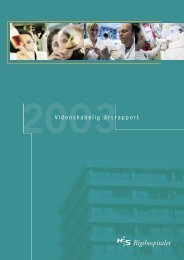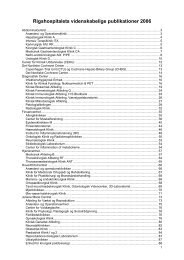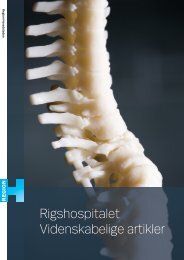View - CTU
View - CTU
View - CTU
You also want an ePaper? Increase the reach of your titles
YUMPU automatically turns print PDFs into web optimized ePapers that Google loves.
Bj¢rndal & Reit Adoption of new technology<br />
Adoption of n<br />
that influence the quality of root canal treatment<br />
performed in general dental practice. It might be<br />
assumed that such factors will relate not only to the<br />
individual dentist (knowledge, attitudes and skills), but<br />
also to the context in which he or she works. For<br />
example, the remuneration system, time pressure,<br />
patient expectations, and inadequate equipment have<br />
been expressed by British dental practitioners to have<br />
bearing on treatment quality (McColl et al. 1999).<br />
Within the last decade major technological breakthroughs<br />
have been made. The advent of nickeltitanium<br />
alloy and alternative methods to introduce<br />
gutta-percha were designed to simplify the procedure<br />
and thus improve the technical treatment results.<br />
Studies have shown the superiority of nickel-titanium<br />
files over conventional instruments to shape the root<br />
canal (Bishop & Dummer 1997, Park 2001, Schafer &<br />
Lohmann 2002), and Molander et al. (2003) observed<br />
an increased frequency of good-quality root fillings<br />
when a group of Swedish practitioners were trained to<br />
use a NiTi rotary system. Furthermore, electronic apex<br />
locators are claimed to be more reliable than radiographs<br />
to identify the working length of the root canal<br />
(Pratten & McDonald 1996), and the recommendation<br />
today is that working length determination should be<br />
carried out using a combination of an apex locator and<br />
radiography (Hoer & Attin 2004). Finally, systems<br />
using warm gutta-percha are more rapid (Dummer<br />
et al. 1994, Gulabivala et al. 1998).<br />
The concept of new technology is not limited to<br />
'hardware' innovations, such as those mentioned<br />
above. The concept also include 'software' components<br />
such as ideas, notions and strategies (Brorson & Wall<br />
1985). Historically endodontic treatment often was<br />
extended to encompass five, six or even seven appointments<br />
(Strindberg 1956). However, based on scientific<br />
studies the trend has been to reduce the number of<br />
appointments; new endodontic technology implies<br />
fewer sessions and often allows treatment in a single<br />
visit (Peters & Wesselink 2002, Kvist et al. 2004).<br />
The idea of protecting teeth with rubber dam is<br />
widely accepted and advocated. However, studies<br />
indicate that most dentists abandon its use as soon as<br />
they enter practice (McColl et al. 1999, Jenkins et al.<br />
2001). Therefore, rubber dam application cannot be<br />
regarded as an innovation but could be perceived as<br />
necessary in combination with the acceptance of, for<br />
example, new root canal instrumentation techniques.<br />
Studies of the diffusion of widely accepted technologies<br />
have often found that, at first, only a few<br />
individuals (the so-called innovators) adopt the<br />
100%<br />
80%<br />
.g =<br />
! 60%<br />
'O<br />
§ 40%<br />
~<br />
"'<br />
20%<br />
Later adopters<br />
Figure 1 An s-shaped diffusion curve illustrating the typical<br />
development over time for the spread of an idea, practice, or<br />
object that is perceived as new by an individual (innovation).<br />
At first a group of earlier adopters appears, being about<br />
10-25% of all potential users of the innovation in focus. Later<br />
on a so-called 'take-off is noted when interpersonal networks<br />
become activated (modified from Rogers 1983).<br />
innovation. Following an early, relatively slow, phase<br />
that includes 10-20% of the potential adopters, the<br />
diffusion curve (Fig. 1) starts to climb, as more and<br />
more persons adopt the technology. Finally, the curve<br />
levels off to describe an s-form (Rogers 1983). The<br />
steepness of the curve will vary between innovations.<br />
There is little data available on the diffusion rate of<br />
new endodontic technology amongst general dental<br />
practitioners. Therefore, the aim of the present study<br />
was to (i) investigate the rate of adoption amongst a<br />
group of Danish general practitioners (GPs) and<br />
(ii) determine the factors associated with such an<br />
adoption.<br />
Materials and methods<br />
In January 2003 a questionnaire and an addressed<br />
return envelope were sent to all 1156 members of the<br />
Copenhagen Dental Association (CDA). The purpose of<br />
the anonymous survey was stated in an explanatory<br />
note. After 4 weeks all CDA members received a<br />
reminder. In addition, an announcement was attached<br />
to the website of the Danish Dental Association, and<br />
also placed in an issue of the Danish Dental Journal<br />
(Tandlaegebladet).<br />
The first part of the questionnaire asked for information<br />
regarding gender, year of graduation, and the<br />
average number of root canal treatments performed per<br />
week. The second part of the questionnaire consisted of<br />
14 questions concerned with the frequency of which<br />
various enc<br />
dures wen<br />
respondent<br />
never. At p<br />
specialist p<br />
mation fro.<br />
mation fr01<br />
Statistical<br />
All statisU<br />
association<br />
Most often<br />
therefore t<br />
kal's y-coi<br />
similar to i<br />
indicating<br />
negative a<br />
formed as<br />
Digram (U<br />
Results<br />
By using c<br />
possible t<br />
dentists i<br />
amongst<br />
university<br />
be infreql<br />
study. Th<br />
private pi<br />
(72.4%) c<br />
Of the 1<br />
of gender<br />
The relati<br />
250<br />
200<br />








